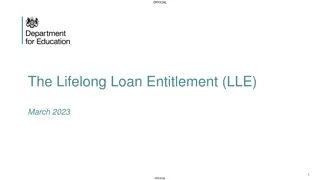Worker Retraining Program Overview and Funding Distribution
The Worker Retraining Program in Washington State focuses on re-employing dislocated workers in high-demand fields. With funding of nearly $40 million annually, the program supports training, tuition, and support services at Community and Technical Colleges. Enrollment trends correlate with state unemployment rates, with a proviso established in 1993 directing a minimum number of served FTEs each year. Funding distribution shows that most funding goes to CTCs, while the program follows a fluid FTEs funding formula.
Download Presentation

Please find below an Image/Link to download the presentation.
The content on the website is provided AS IS for your information and personal use only. It may not be sold, licensed, or shared on other websites without obtaining consent from the author.If you encounter any issues during the download, it is possible that the publisher has removed the file from their server.
You are allowed to download the files provided on this website for personal or commercial use, subject to the condition that they are used lawfully. All files are the property of their respective owners.
The content on the website is provided AS IS for your information and personal use only. It may not be sold, licensed, or shared on other websites without obtaining consent from the author.
E N D
Presentation Transcript
WORKER RETRAINING PROGRAM Enrollment & Funding Anna Nikolaeva Shanna McBride
AGENDA Welcome and Introductions Intent of today s meeting WRT Current State Overview WRT Formula Overview WRT Workgroup Scope and Recommendations Recommendations pros and cons Q&A 2
WORKER RETRAINING PROGRAM OVERVIEW Purpose: Purpose: Re-employ Washington State s dislocated workers in wage recovery jobs while building capacity for training in high-demand, high-wage fields Funding: Funding: Just under $40M each fiscal year Approximately $38M distributed across CTC system $1.5M dispersed to private career schools through competitive contracting Program Features Program Features (for CTCs) Must establish student eligibility Base allocation/variable allocation Provides training, tuition, books/fees, support services (for CTCs): : 3
HOW MANY PEOPLE ARE WE SERVING? Annual WRT Enrollment (FTEs) 1994-2023 at Community and Technical Colleges compared to state's annual unemployment rates 16000 12.00% Annual enrollment trends typically follow unemployment rates. 2022-23 academic year saw the lowest enrollment since program s inception, with 4666 full-time equivalent students served. At its peak, the program served 13,403 FTEs in 2011. 14000 10.00% 12000 8.00% 10000 8000 6.00% 6000 4.00% 4000 2.00% 2000 0 0.00% 1994 1995 1996 1997 1998 1999 2000 2001 2002 2003 2004 2005 2006 2007 2008 2009 2010 2011 2012 2013 2014 2015 2016 2017 2018 2019 2020 2021 2022 2023 4
WORKER RETRAINING PROGRAM PROVISO Established in 1993 Proviso directs the program to serve at least 7,170 FTEs with appropriated funds*: *additional ~6M is added to the program via an earmark with no additional FTE targets, totaling $39,759,100 overall for the program 5
WRT FUNDING Funding from State General Fund $39,759,100 Annually Community and Technical Colleges (CTCs) 7176 FTES $37,586,982 (includes $23,823 co-loc per college) Private Career Schools and Colleges (PCSCs) 430 FTES $1,640,880 Administration (to SBCTC) $497,555 Emergency Set-Aside (not shown in chart) $33,683 WRT Funding Distribution Admin 1% PCSCs 4% CTCs 95% 6
FUNDING FORMULA: Fluid WRT FTES Fluid WRT FTES Base WRT FTES Base WRT FTES FTES FTES TARGET TARGET Funding is split between instructional support (faculty salaries, equipment, space, etc.) and student supports (tuition, fees, emergency needs, etc.), 70/30 Prior funding and service levels Static for 10+ years Base accounts for 65% of system s WRT allocation or 4,730 FTEs Individual colleges base/fluid ratio ranges from 50% to 83% 60% - 2-year performance average as a share of available FTEs 40% - regional unemployment share of available FTEs Fluid FTES account for 35% of system s WRT allocation or 2,446 FTEs 7
CAMPUS EXAMPLES Base Base 225 33 44 176 Fluid Fluid 74 32 41 82 Total Total 299 65 85 258 FY23 Enrollment FY23 Enrollment 94 106 111 116 College A College B College C College D 8
WRT WORKGROUPS SCOPE Goal: Propose an updated WRT funding model that is both predictable for the colleges and responsive to the regional unemployment needs. Out of Scope: Legislative funding requests for 2025 operating budget. Solutions that require opening up guiding legislation (RCW 28C.04.390) or updating the proviso, including adjusting FTE rate IT systems (i.e., ctcLink) redesign or system purchases. Private Career School s WRT funding or SBCTC administration funds In Scope: Evaluation of the current WRT funding model Update to the funding model, limited to: Funding formula Base allocation, variable/fluid allocation Instruction/student support split 9
RECOMMENDATIONS 1) Maintain elements of the formula but recalculate the base allocation for each college. New base would be 75% of 5-year enrollment averages 2) Same as Option 1, but with incremental roll-out over three years. For example, if College A s base is reduced by 99 FTEs compared to current, FY25 would see base reduction of 33 FTEs only. 3) Make no changes Proceed with the current formula elements. 10
RECOMMENDATION 1: UPDATE THE BASE ALLOCATION USING EACH COLLEGES 75% OF 5-YEAR WRT ENROLLMENT AVERAGE. Pros: - Addresses disparities in funding distribution - Acknowledges actual performance levels, based on pre-, during, and post-pandemic enrollment trends, directing funding to campuses with higher WRT enrollments - Narrows the range of base to variable ratios across the system to 20% - Provides all colleges with funding levels that are at or above 5-year service averages* - Maintains the overall base/fluid split unemployment numbers. Cons: - Sizeable impacts on several colleges - Most recent performance data, particularly during COVID years, may not accurately predict future performance (solution: regular base review schedule) *estimates based on prior UI/enrollment levels. Actual award numbers are not available until February 2024, when ESD updates December 2023 11
CAMPUS EXAMPLES Base Base Fluid Fluid Total Total New Base New Base Fluid Fluid New New Total* Total* FY23 FY23 Enrollme Enrollme nt nt 94 106 111 116 5 5- -YR YR Average Average College A College B College C College D 225 33 44 176 74 32 41 82 299 65 85 258 107 86 109 147 79 47 36 74 186 133 145 221 142 115 146 196 *estimates based on prior UI/enrollment levels. Actual award numbers are not available until February 2024, when ESD updates December 2023 unemployment numbers. 12
RECOMMENDATION 2: UPDATE THE BASE ALLOCATION USING EACH COLLEGES 75% OF 5-YEAR WRT ENROLLMENT AVERAGE. ROLL OUT CHANGES OVER THREE YEARS. Pros: - Softens immediate impacts on affected colleges Cons: - Necessitates significant adjustments to planned spending every year for three years. - Most recent performance data, particularly during COVID years, may not accurately predict future performance (solution: regular base review schedule) - significant impacts on several colleges - Addresses disparities in funding distribution - Acknowledges actual performance levels, based on pre-, during, and post-pandemic enrollment trends, directing funding to campuses with higher WRT enrollments - Eventually narrows the range of base to variable ratios across the system to 20% - Provides all colleges with funding levels that are at or above 5-year service averages* *estimates based on prior UI/enrollment levels. Actual award numbers are not available until February 2024, when ESD updates December 2023 unemployment numbers. - Maintains the overall base/fluid split 13
RECOMMENDATION 3: TAKE NO ACTION. MAINTAIN THE CURRENT BASE ALLOCATION TO EACH COLLEGE; MAINTAIN THE CURRENT FORMULA Pros: - Administrative efficiency and minimal disruption to colleges - Flexibility for future change Cons: - Maintains a broad range of base to fluid ratio in the system - Base FTE does not accurately reflect recent service levels - In the current environment of lower than usual enrollments, the voluntary redistribution process accommodates the needs of those colleges that experience higher enrollments than initial allocation levels. - Colleges with low base allocations are unable to meet the needs of WRT-eligible students on their campuses without reliance on give-backs from other colleges 14
NEXT STEPS Review impact on each campus and overall CTC system SBCTC staff are available for 1:1s to discuss details ESD updates 2023 unemployment numbers, SBCTC determines actual award amounts WACTC will consider proposed options WACTC may recommend a legislative solution for future sessions 15
QUESTIONS FOR THE SBCTC TEAM? CC BY 4.0, except where otherwise noted.























